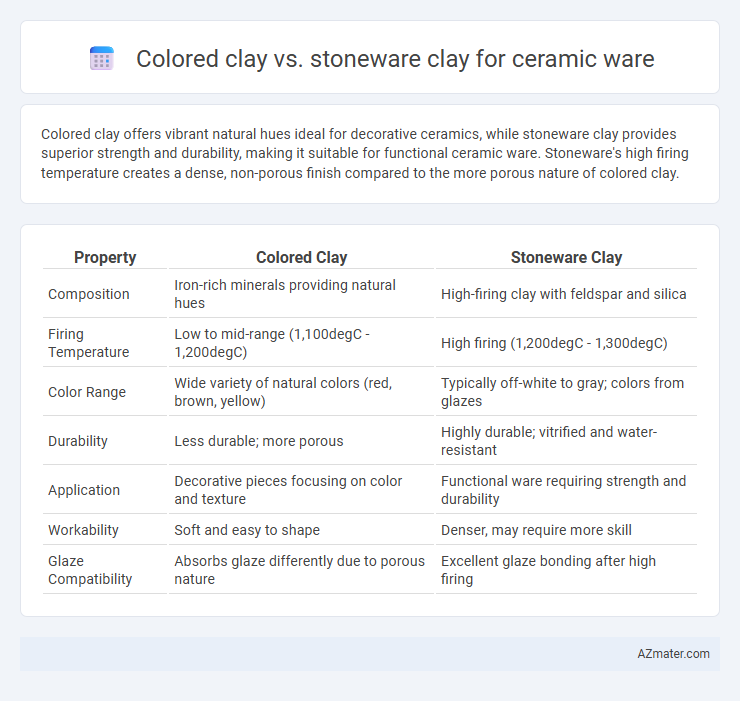Colored clay offers vibrant natural hues ideal for decorative ceramics, while stoneware clay provides superior strength and durability, making it suitable for functional ceramic ware. Stoneware's high firing temperature creates a dense, non-porous finish compared to the more porous nature of colored clay.
Table of Comparison
| Property | Colored Clay | Stoneware Clay |
|---|---|---|
| Composition | Iron-rich minerals providing natural hues | High-firing clay with feldspar and silica |
| Firing Temperature | Low to mid-range (1,100degC - 1,200degC) | High firing (1,200degC - 1,300degC) |
| Color Range | Wide variety of natural colors (red, brown, yellow) | Typically off-white to gray; colors from glazes |
| Durability | Less durable; more porous | Highly durable; vitrified and water-resistant |
| Application | Decorative pieces focusing on color and texture | Functional ware requiring strength and durability |
| Workability | Soft and easy to shape | Denser, may require more skill |
| Glaze Compatibility | Absorbs glaze differently due to porous nature | Excellent glaze bonding after high firing |
Introduction to Colored Clay and Stoneware Clay
Colored clay offers vibrant hues naturally infused during the clay mixing process, enhancing the aesthetic appeal of ceramic ware without the need for additional glazes. Stoneware clay, known for its dense, durable, and non-porous properties, provides exceptional strength after firing at high temperatures, making it ideal for functional pottery. The choice between colored clay and stoneware clay depends on the desired visual effect and the functional requirements of the final ceramic piece.
Composition Differences Between Colored and Stoneware Clays
Colored clay contains higher amounts of iron oxide and other mineral pigments that give it distinct hues, while stoneware clay is typically a mix of natural clay, silica, and feldspar with lower pigment content. The increased mineral concentration in colored clay affects its firing temperature and plasticity, making it suitable for decorative ceramics but less durable than stoneware. Stoneware clay's composition promotes higher vitrification, resulting in a dense, non-porous material ideal for functional dinnerware and cookware.
Color Range and Aesthetic Possibilities
Colored clay offers a diverse spectrum of naturally integrated hues, allowing artists to create vibrant and varied ceramic wares without relying on glazes. Stoneware clay typically presents earthy tones like gray, brown, or buff, providing a neutral base that highlights glaze applications and surface textures. The broader color range in colored clay expands aesthetic possibilities by enabling multi-colored effects and intricate patterns through clay body combinations, while stoneware's muted palette emphasizes form and glaze artistry.
Workability and Handling Characteristics
Colored clay typically features higher plasticity, making it easier to shape and mold for intricate ceramic designs, ideal for hand-building techniques. Stoneware clay is denser and less porous, offering robust durability but requiring more effort to manipulate due to its heavier, stiffer texture. The workability of colored clay supports detailed artistry, while stoneware clay excels in producing strong, functional ware that withstands high firing temperatures.
Drying and Shrinkage Behavior
Colored clay typically exhibits higher shrinkage rates during drying compared to stoneware clay, due to its finer particle size and added pigments affecting moisture retention. Stoneware clay demonstrates more uniform drying with reduced warping risks, attributed to its coarser granules and higher plasticity, which accommodate moisture loss without significant deformation. Understanding these differences is crucial for optimizing firing schedules and minimizing defects in ceramic ware production.
Firing Temperatures and Kiln Compatibility
Colored clay, often rich in iron oxide, typically fires at lower temperatures ranging from cone 06 to cone 04 (1828degF to 1945degF), making it compatible with low-fire kilns such as electric or gas kilns designed for earthenware. Stoneware clay requires higher firing temperatures between cone 5 and cone 10 (2167degF to 2345degF), demanding kilns capable of reaching these elevated temperatures, like gas, wood, or electric kilns built for stoneware or porcelain. The firing temperature directly affects the clay's maturation, durability, and glaze application, necessitating kiln selection based on the specific firing range of colored or stoneware clay.
Durability and Final Strength
Colored clay typically contains added pigments or oxides that may slightly reduce its overall durability compared to stoneware clay, which is known for its robust composition and higher firing temperatures. Stoneware clay vitrifies at temperatures between 1200degC to 1300degC, resulting in a dense, non-porous, and highly durable ceramic body ideal for functional ware subjected to daily use. The final strength of stoneware exceeds that of colored clay, making it more resistant to chipping, cracking, and thermal shock in practical applications.
Glazing and Surface Finishing Options
Colored clay offers inherent pigmentation that reduces the need for heavy glazing, allowing for natural surface finishes and subtle matte or satin effects, which highlight the clay body's hue and texture. Stoneware clay, prized for its durability and high firing temperature, supports a wider variety of glaze applications including glossy, crackled, or textured finishes that enhance both aesthetic and functional properties. Glazing stoneware can improve water resistance and create vibrant color contrasts, while colored clays often pair best with transparent glazes that showcase their rich, natural colors.
Suitability for Functional vs Decorative Ceramics
Colored clay offers vibrant hues and is ideal for decorative ceramics, enhancing aesthetic appeal without requiring additional glazing. Stoneware clay, known for its durability and high firing temperature tolerance, is more suitable for functional ceramics such as dinnerware and cookware due to its strength and resistance to water. The choice between colored clay and stoneware clay depends on whether the ceramic piece prioritizes artistic expression or practical utility.
Cost Considerations and Availability
Colored clay typically involves additional pigments and processing, increasing its cost compared to more readily available stoneware clay, which is often sourced in large quantities from local or regional suppliers. Stoneware clay's broad availability makes it a cost-effective choice for ceramic ware production, especially in bulk manufacturing. The price difference between colored and stoneware clays can significantly impact project budgets, with colored clays often preferred for artistic pieces despite higher expense.

Infographic: Colored clay vs Stoneware clay for Ceramic ware
 azmater.com
azmater.com